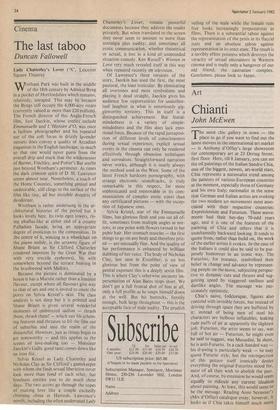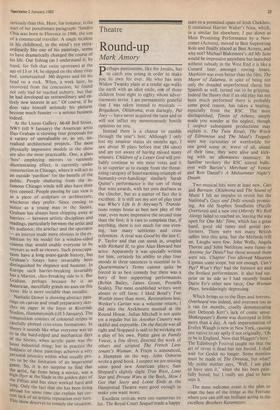Art
Chianti
John McEwen
The most chic gallery in town the -- place to go if you want to find out the latest movers in the international art market — is Anthony d'Offay's large showroom for contemporary art at 23 Dering Street, first floor. Here, till 8 January, you can see the oil paintings of the Italian Sandro Chia, one of the biggest, newest, art-world stars, Chia represents a nationalist trend among the painters of various European countries at the moment, especially those of Germany and his own Italy; nationalist in the sense that German and Italian artists are evoking- the two modern art movements most asso- ciated with their respective countries: Expressionism and Futurism. These move- ments had their hey-day 70-odd years ago, and it is one of the features of the painting of Chia and others that it is unashamedly backward looking. It tends to quote from, rather than build on, the work of the earlier artists it evokes. In the case of the Italians it could also be said to be pur- posely humorous in an ironic way. The Futurists, for instance, symbolised their belief in change and advance by represent- ing people on the move, subjecting perspec- tive to dynamic cuts and thrusts and sug- gesting speed by staggered outlines and dartlike angles. The message was pas- sionately optimistic.
Chia's naive, folklorique, figures also contend with invisible forces, but instead of driving through space they are buffeted by it; instead of being men of steel his characters are bulbous inflatables, leaking rude puffs of air at apparently the slightest jolt. Futurism, the artist seems to say, was full of hot air — Futurism, he might even be said to suggest, was Mussolini. In short, he is anti-Futurist. In a cack-handed way his drawing is particularly weak — he may quote Futurist style, but the retrospection of this gesture itself ironically denies everything the original Futurists stood for, most of all their wish to abolish the past. And, of course, by extension he would seem equally to ridicule any current idealism about painting. At least, this would seem to be the message. Reading Anne Seymour's (Mrs d'Offay) catalogue essay, however, It looks as if Chia takes himself much more
seriously than this. Here, for instance, is the start of her penultimate paragraph: `Sandro Chia was born in Florence in 1946, the son of a commercial traveller. A single incident in his childhood, in the mind's eye extra- ordinarily like one of his paintings, seems to have dramatically changed the course of his life. Out fishing (as I understand it, by hand, for fish that swim upstream) at the age of 13 or 14, he slipped on the slimy river bed, somersaulted 360 degrees and hit his head on a rock. When, a week later, he recovered from the concussion, he found not only had he reached puberty, but that he had developed an extraordinary and en- tirely new interest in art.' Of course, if he does take himself seriously his pictures become much funnier — a serious business indeed.
At the Lisson Gallery, 66-68 Bell Street, NW1 (till 9 January) the American artist Dan Graham is showing four proposals for a variety of unrealisable or, as yet, un- realised architectural projects. The most physically impressive models in the show are also the most practicable. One, a glass `box' employing mirrors to variously disorientating effect, is currently under construction in Chicago, where it will act as an outside 'pavilion' for the benefit of the public. People sheltering from the in- famous Chicago winds will also have their eyes opened. People passing by can view it as a piece of sculpture or architecture, whichever they prefer. Since coming to notice as a young man in the Sixties, Graham has always been chipping away at barriers — between artistic disciplines and readings, particularly between the artist and his audience, the artefact and the spectator — an interest made more obvious in the ex- hibition by his model for a window-sided cinema that would enable everyone to be voyeurs as well as viewers. Such preoccupa- tions have a long avant-garde history, but Graham's forays have invariably been distinguished by elegance and humour. In Europe such barrier-breaking invariably has a Marxist, class-breaking side to it. But Graham, perhaps because he is an American, mercifully grinds no axes on this score. He is more sociable than socialist.
Nathalie Dower is showing abstract pain- tings on canvas and small preparatory sket- ches on paper in the foyer at Riverside Studios, Hammersmith (till 3 January). The composition consists of coloured stripes in carefully plotted criss-cross formations. In theory it sounds like what everyone was up to in the hard-edged and mechanical days of the Sixties, when acrylic paint was the latest industrial thing; but in practice the boldness of these paintings achieves a very Personal intensity within what usually pro- ves to be the limitation of an impersonal genre. So, it is no surprise to find that the far from being a novice, was a high_flyerat the Slade in the golden days of the Fifties and has since worked hard and long. Only the fact that she has been living abroad for some time can explain her cur- rent lack of an artistic reputation over here. This show deserves to remedy the situation.



































 Previous page
Previous page